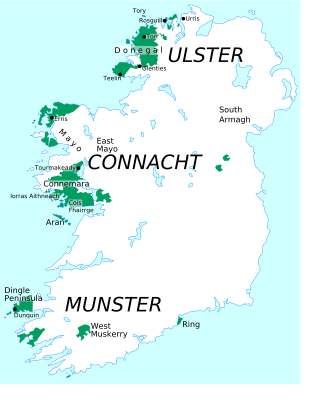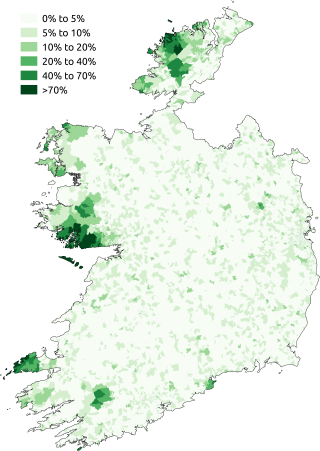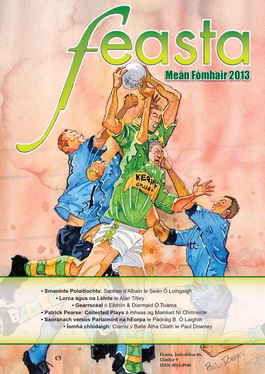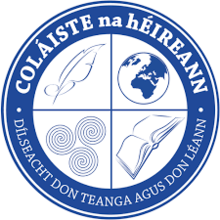
A Gaeltacht is a district of Ireland, either individually or collectively, where the Irish government recognises that the Irish language is the predominant vernacular, or language of the home. The Gaeltacht districts were first officially recognised during the 1920s in the early years of the Irish Free State, following the Gaelic revival, as part of a government policy aimed at restoring the Irish language.

A Gaelscoil is an Irish language-medium school in Ireland: the term refers especially to Irish-medium schools outside the Irish-speaking regions or Gaeltacht. Over 50,000 students attend Gaelscoileanna at primary and second levels on the island of Ireland. Additionally, more than 13,000 students are receiving their primary and second level education through Irish in the Gaeltacht. Gaelscoileanna and Irish-medium schools in the Gaeltacht are supported and represented by Gaeloideachas and An Chomhairle um Oideachas Gaeltachta & Gaelscolaíochta or COGG in the Republic of Ireland and by Comhairle na Gaelscolaíochta in Northern Ireland. The largest patron body of Gaelscoileanna in the Republic of Ireland is An Foras Pátrúnachta, although the vast majority of schools under their patronage are at primary level.
Irish orthography is the set of conventions used to write Irish. A spelling reform in the mid-20th century led to An Caighdeán Oifigiúil, the modern standard written form used by the Government of Ireland, which regulates both spelling and grammar. The reform removed inter-dialectal silent letters, simplified some letter sequences, and modernised archaic spellings to reflect modern pronunciation, but it also removed letters pronounced in some dialects but not in others.

Gweedore is a Gaeltacht (Irish-speaking) district and parish located on the Atlantic coast of County Donegal in the north-west of Ireland. Gweedore stretches some 26 kilometres (16 mi) from Glasserchoo and Bloody Foreland in the north to Crolly in the south and around 14 kilometres (9 mi) from Dunlewey in the east to Magheraclogher and Magheralosk in the west, and is sometimes described as one of Europe's most densely populated rural areas. It is the largest Irish-speaking parish in Ireland with a population of around 4,065, and is also the home of the northwest regional studios of the Irish-language radio service RTÉ Raidió na Gaeltachta, as well as an external campus of the University of Galway. Gweedore includes the settlements of Brinlack, Bunbeg, Derrybeg, Crolly and Dunlewey, and sits in the shade of County Donegal's highest peak, Errigal.

Máirtín Ó Cadhain was one of the most prominent Irish language writers of the twentieth century. Perhaps best known for his 1949 novel Cré na Cille, Ó Cadhain played a key role in reintroducing literary modernism into modern literature in Irish, where it had been dormant since the 1916 execution of Patrick Pearse. Politically, Ó Cadhain was an Irish republican and anti-clerical Marxist, who promoted the Athghabháil na hÉireann, . Ó Cadhain was also a member of the post-Civil War Irish Republican Army and was interned by the Irish Army in the Curragh Camp with Brendan Behan and many other IRA members during the Emergency.
Niall Ó Dónaill was an Irish language lexicographer from Ailt an Eidhinn, Loughanure, County Donegal, Ireland. He was the oldest of the six children of Tarlach Ó Dónaill and Éilis Nic Ruairí from Grial, Loughanure. They had a little land and a few cows. His father, Tarlach, would spend June to November working for a farmer in Scotland and died when Niall was 13 years old. Ó Dónaill himself spent summers working in the tunnels in Scotland.
Tomás Mac Síomóin was an Irish doctoral graduate of Cornell University, New York, who worked as a biological researcher and university lecturer in the US and Ireland. He worked as a journalist, as editor of the newspaper Anois and for many years was editor of the literary and current affairs magazine, Comhar. He wrote in Irish and published both poetry and fiction in that language.

Acadamh na hOllscolaíochta Gaeilge is a third level educational and research institution headquartered in Galway, Ireland. It was established as part of the National University of Ireland - Galway in 2004, to further the development Irish-medium education. The academy works in co-operation with faculties, departments and other university offices to develop the range and number of programmes that are provided through the medium of Irish on campus and in the academy's Gaeltacht centres.

The official status of the Irish language has remained high in the Republic of Ireland from foundation. This reflects the dominance of the language in Irish cultural and social history until the nineteenth century and its role in Irish cultural identity. In 2022, strong recognition was added in Northern Ireland also. In the 2022 Republic of Ireland census 1,873,997 people or 39.8% of the population in the Republic of Ireland said that they had some ability to speak Irish, out of an overall population of 5,149,139. In Northern Ireland 228,600 people (12.4%) have some ability in the Irish language according to the 2021 census for Northern Ireland, out of a population of 1,903,175 people. It has been found, however, that while ideological support for Irish is high, actual routine use is very low, and that there is very little or rare correlation between personal fluency in the language and the perceived value of Irish as an identity-marker. Nevertheless, the language benefits from the support of activists who continue to use it as a social and cultural medium.

Feasta is an Irish-language magazine that was established in 1948. Its purpose is the furtherance of the aims of Conradh na Gaeilge, an objective reflecting the cultural nationalism of the language movement, and the promotion of new writing. Feasta describes itself as a review of Irish thought, literature, politics, and science. It was formerly supported by Foras na Gaeilge, but this support was withdrawn because of a review of funding priorities. At present the magazine relies on its own resources.
An Caighdeán Oifigiúil, often shortened to An Caighdeán, is the variety of the Irish language that is used as the standard or state norm for the spelling and the grammar of the language and is used in official publications and taught in most schools in the Republic of Ireland. The standard is based on the three Gaeltacht dialects: Connacht Irish, Munster Irish and Ulster Irish. In Northern Ireland and County Donegal, the Ulster dialect is used extensively alongside the standard form as the spoken language in primary and secondary schools.
An Cumann Gaelach is the Irish language and culture society in Trinity College Dublin. Established in 1907 by Ireland's first president Dubhghlas de hÍde, the society is among the largest societies in Trinity College, and one of the largest Cumann Gaelach student groups in the country.
Séamus Ó hEocha nicknamed "An Fear Mór", was an Irish educator and briefly an independent senator. He was active in the Gaelic League and became head teacher of Coláiste na Rinne in County Waterford.

Evanne Ní Chuilinn is an Irish sports journalist and television presenter. She currently works as a sports news presenter on RTÉ News: Six One.

The Basque Summer University is a university institution created in 1973, which works to promote extensive use of Basque language at the university level. It promotes courses, book publications, Internet services, congresses, professional meetings and postgraduate degrees at university level and in Basque. It offers university courses in collaboration with the University of the Basque Country, Mondragon University, Public University of Navarra, the University of Pau and Pays de l'Adour in Bayonne, and Basque Wikipedia.

Kevin Scannell is an American professor of mathematics and computer science at Saint Louis University.
Lil Nic Dhonnchadha was an Irish language scholar and language activist.
Risteárd Ó Glaisne was a Methodist Irish language activist, teacher and writer.












